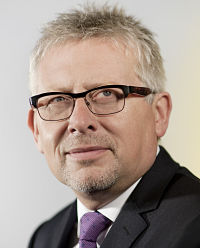 Regulators on both sides of theAtlantic have been looking at ways of making the money market fundindustry more robust, and one of the options they've focused on ismoving from a stable, or constant, net asset value (CNAV) model toa floating or variable (VNAV) model.
Regulators on both sides of theAtlantic have been looking at ways of making the money market fundindustry more robust, and one of the options they've focused on ismoving from a stable, or constant, net asset value (CNAV) model toa floating or variable (VNAV) model.
The prospect of a move to floating NAV faltered in the U.S. inAugust when Securities and Exchange Commission Chairman MarySchapiro called off a vote on proposed reforms to money-marketfunds that included moving to a floating NAV and imposing a capitalbuffer. Nevertheless, regulators in both the U.S. and Europecontinue to focus on a floating NAV as a possible outcome. InOctober, the International Organization of Securities Commissionpublished a report that suggested, among other things, that stableNAV funds should be converted to floating NAV where workable.
|Floating NAV funds do not maintain a share price of $1 (or €1 or£1), unlike stable NAV funds. Instead, the pricefluctuates in line with mark-to-market valuations. While somebelieve this type of fund is more robust and less susceptible toredemptions during a liquidity crisis, the floating NAV model isunpopular among many corporate treasurers. Numerous surveys haveshown the majority of treasurers would shift assets out of moneymarket funds if the only type available were the VNAV model. Butare their fears justified?
|Colin Cookson, managing director of global liquidity atU.K.-based Aviva Investors, argues that they're not. In 2008,following the collapse of Lehman Brothers, Aviva made the unusualdecision to convert all of its stable NAV funds to the floating NAVmodel.
|“We were told by a senior member of the fund community that we'dhave no clients left within a week,” says Cookson, pictured above.“Since then we've added several billion of assets and new funds. Ithink the main issue for investors into VNAV funds is the fear ofthe unknown.”
|Proponents of stable NAV funds argue, among other things, thatthe floating model means additional accounting complexities.“Corporate treasurers like the [stable NAV] function within a moneymarket fund as it holds a stable price of one – and myunderstanding is this makes it easier to classify as a cashinstrument,” observes Jennifer Gillespie, head of money markets atLegal & General Investment Management in London. “Should [moneymarket funds] move to VNAV, then this becomes a daily movingprice.”
|Nevertheless, this is not necessarily anobstacle. Jarno Timmerman, chief dealer at paint and coatingscompany AkzoNobel in the Netherlands, says the companyhas used a VNAV fund. “Although it was a VNAV fund, oursystems were set up in a way that enabled us to account for it asthough it were a CNAV fund,” Timmerman explains. “If CNAV funds hadto become VNAV, that wouldn't change the way that we usemoney-market funds.”
|It is worth noting that floating NAV funds don't necessarilyexperience price fluctuations. Since Aviva adopted the VNAV model,the valuation of its funds has never moved away from one, whetherthat's £1 or 1 euro, Cookson says. And he argues that thepossibility of variation should be seen as a strength, rather thana problem.
|“If a CNAV fund breaks the buck, you have to freeze the fund,lock all the cash in, liquidate the assets and pay investors on apro-rata basis,” Cookson points out. “That would clearly take timeto do, which is no good if you are a pension fund or a corporatetreasurer and you need your cash on a daily basis. With the VNAVmodel, investors know that the worst that can happen is a slightfall in the value of their investment.”
|Aviva isn't the first fund manager to offer floating NAVfunds. The money-market industry in France is based upon theVNAV model–and with assets under management of more than $530billion at the end of 2011, France's money fund industry is largerthan that of any other country aside from the U.S.
|Although treasurers prefer stable NAV funds, current marketconditions could make the VNAV model more attractive. Indeed, ifthe European Central Bank cuts rates again, negative yields in theeurozone could make the stable NAV model unsustainable, evenwithout regulatory intervention. In September, Insight Investmentannounced the launch of a floating NAV euro cash fund, stating thatthe new fund was being introduced “as a precaution against furtherrate cuts by the ECB and the difficulties this would impose onmanaging a stable Euro NAV.”
|On the other hand, some treasurers have concerns about the useof money-market funds that go beyond the debate about net assetvalue. “A lot of companies are not using money-market funds at allbecause they are still so nervous about what happened four yearsago, and they don't feel that they have sufficient inside knowledgeto really understand the mechanics of a money market fund,” saysSander Van Tol, a partner at consultancy Zanders Treasury& Finance Solutions in the Netherlands. “They prefer to go forthe easy solution, like investing in T-bills or short-termbonds.”
|Complete your profile to continue reading and get FREE access to Treasury & Risk, part of your ALM digital membership.
Your access to unlimited Treasury & Risk content isn’t changing.
Once you are an ALM digital member, you’ll receive:
- Critical Treasury & Risk information including in-depth analysis of treasury and finance best practices, case studies with corporate innovators, informative newsletters, educational webcasts and videos, and resources from industry leaders.
- Exclusive discounts on ALM and Treasury & Risk events.
- Access to other award-winning ALM websites including PropertyCasualty360.com and Law.com.
*May exclude premium content
Already have an account? Sign In
© 2024 ALM Global, LLC, All Rights Reserved. Request academic re-use from www.copyright.com. All other uses, submit a request to [email protected]. For more information visit Asset & Logo Licensing.







